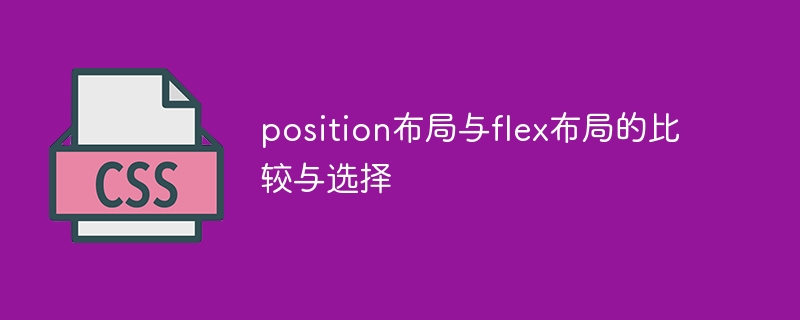Home >Web Front-end >CSS Tutorial >Comparison and selection of position layout and flex layout
Comparison and selection of position layout and flex layout
- PHPzOriginal
- 2023-12-26 14:10:461372browse

Comparison and selection of position layout and flex layout
In front-end development, page layout is a very important part, which determines the position and arrangement of page elements. Way. In CSS, there are many ways to implement page layout, two of the common ways are position layout and flex layout. This article will introduce the characteristics of these two layout methods from the aspects of comparison and examples, so that readers can choose flexibly in actual development.
1. Position layout
Position layout is one of the most basic and commonly used layout methods in CSS. It implements layout by setting the position attribute of the element. Commonly used position attribute values include: static, relative, absolute and fixed.
-
static (default value): The elements are arranged according to the normal document flow, without special positioning, and cannot be adjusted through the top, bottom, left, and right attributes.
<div style="position: static;">Static Box</div>
-
relative: The element is positioned relative to its normal position and can be adjusted through the top, bottom, left, and right attributes.
<div style="position: relative; top: 50px;">Relative Box</div>
-
absolute: The element is positioned relative to the nearest parent element with a positioning attribute (non-static), or relative to the entire page.
<div style="position: absolute; top: 50px; left: 50px;">Absolute Box</div>
-
fixed: The element is positioned relative to the browser viewport and does not change as the page scrolls.
<div style="position: fixed; top: 50px; left: 50px;">Fixed Box</div>
An important feature of position layout is that the stacking order of elements can be adjusted through the z-index attribute.
2. Flex layout
Flex layout is a new flexible box layout model in CSS3. It achieves flexible page layout by setting the flex properties of containers and items. Compared with position layout, flex layout is more convenient and can easily achieve common effects such as horizontal centering and vertical centering.
- Container properties (set on the parent element)
- display: flex; Defines the container as a flex container.
- flex-direction: row | column; Defines the main axis direction, the default is row horizontal direction.
- flex-wrap: nowrap | wrap; Defines whether to wrap or not. The default is nowrap without wrapping.
- justify-content: flex-start | flex-end | center | space-between | space-around; Defines the alignment of items on the main axis.
- align-items: flex-start | flex-end | center | baseline | stretch; Defines the alignment of items on the cross axis.
- Item properties (set on child elements)
- flex: flex-grow flex-shrink flex-basis; Define the stretch properties of the item.
- order:
; Defines the sorting order of items. - align-self: auto | flex-start | flex-end | center | baseline | stretch; Defines the alignment of the item itself on the cross axis.
The following is a sample code for flex layout:
<div class="flex-container"> <div class="flex-item">Item 1</div> <div class="flex-item">Item 2</div> <div class="flex-item">Item 3</div> </div>
.flex-container {
display: flex;
justify-content: center;
align-items: center;
}
.flex-item {
flex: 1;
margin: 10px;
}With the above code, we create a flex container and use the justify-content and align-items attributes to achieve it The centering effect of child elements within the container.
3. Comparison and selection
In actual development, we should flexibly choose position layout and flex layout according to specific needs.
- Position layout is suitable for precise positioning and cascading settings of elements, and is especially suitable for realizing common effects such as floating windows and navigation bars.
- Flex layout is suitable for quickly implementing adaptive layout of the page. It can reduce the amount of code and can easily achieve effects such as vertical centering and horizontal centering.
In some complex layout scenarios, we can also use position layout and flex layout together to give full play to their advantages.
Summary:
This article introduces the characteristics and usage of two common page layout methods, position layout and flex layout, and gives corresponding code examples. In actual development, we should choose appropriate layout methods according to actual needs and use them flexibly to achieve the desired effects.
The above is the detailed content of Comparison and selection of position layout and flex layout. For more information, please follow other related articles on the PHP Chinese website!
Related articles
See more- Summary of definition and usage of position positioning function
- How to use flex layout to center multiple rows and multiple divs horizontally and vertically
- CSS3 What is flexbox? The difference and usage of flex and box attribute values in the display attribute
- What are the JavaScript string comparison methods?
- Which one is more difficult, PS or PR?

